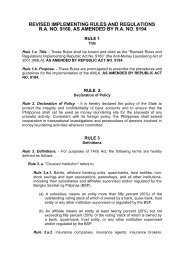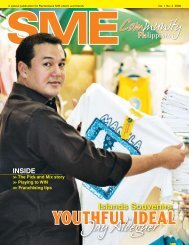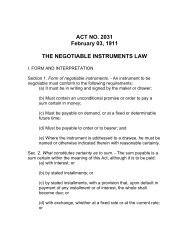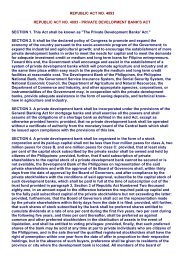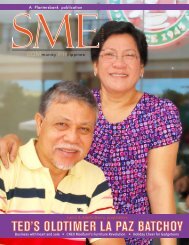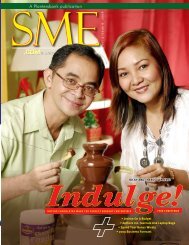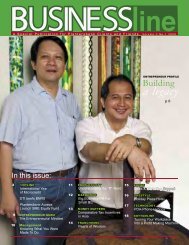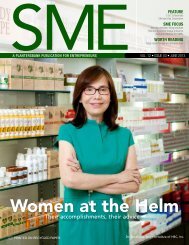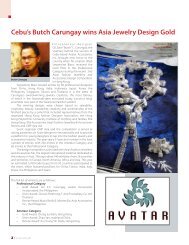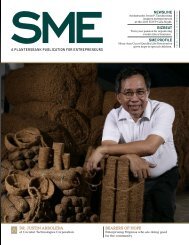SME Community - Planters Development Bank
SME Community - Planters Development Bank
SME Community - Planters Development Bank
Create successful ePaper yourself
Turn your PDF publications into a flip-book with our unique Google optimized e-Paper software.
“Over the five<br />
years we developed a<br />
very clear cut leading<br />
edge that would<br />
distinguish us in the<br />
market. In this scale<br />
of production, we’re<br />
the only one”<br />
Photos by Carlo Sanchez<br />
Hues of red, yellow, brown, pink,<br />
peach, and white welcome Gerry<br />
and Gie Bote every time they visit<br />
their anthurium farm located at the foot of<br />
Mt. Malarayat in Batangas.<br />
With the sprawling land, fresh air and<br />
coconut trees, it could pass off as a vacation<br />
house or perhaps the perfect retirement<br />
farm. But, this five-hectare land isn’t meant<br />
for relaxation.<br />
It is the home of Agrikultura Pilipina<br />
Inc., the biggest anthurium business in the<br />
country. They harvest 8,000 flowers, twice<br />
a week—which totals to almost a million<br />
picked flowers in a year.<br />
A risk taker<br />
When he started the business, Gerry<br />
had no passion for taking care of plants or<br />
flowers. But when the opportunity knocked,<br />
his strong entrepreneurial spirit ignited his<br />
interest.<br />
In the 1980’s, Hawaii (pioneer in<br />
commercial anthurium growing) was struck<br />
by a plant epidemic that almost wiped out<br />
their anthurium industry. Gerry and Gie saw<br />
then the potential for growing anthuriums<br />
in the country. “We had land, we didn’t<br />
know what to do with it. And we thought,<br />
we’re closer to Japan (prime importer of<br />
anthuriums) than Hawaii is to Japan, and so<br />
we jumped into it,” Gerry narrates.<br />
Going into the business half-blind,<br />
Gerry learned the ropes of farming and the<br />
special demands of anthuriums, the hard<br />
way. “They are very difficult to grow. If I knew<br />
what I know now, I wouldn’t get into it,” he<br />
features<br />
jokingly remarks. “Farming is not easy, it’s<br />
not for retirement! You can’t manage from<br />
the top,” he adds with a tone of experience<br />
in his voice.<br />
The first greenhouse was put up in<br />
1992 on half a hectare of land. For five<br />
years, Gerry stayed in Batangas to manage<br />
the farm full-time. His wife managed their<br />
other businesses and stayed with their kids<br />
in Manila.<br />
The couple had to make this sacrifice<br />
after they were troubled by an insect<br />
infestation at the early stage of business.<br />
“It was just a few months after we started.<br />
Because of the infestation, we threw 20,000<br />
flowers a month for six months! Every<br />
blemished or scratched flower can’t be<br />
exported to Japan’,”he recalls.<br />
In order to control the pests, Gerry<br />
and agriculturist/industrial partner Nikon,<br />
employed techniques that combined<br />
the careful use of chemicals and good<br />
management. Their hard work eventually<br />
paid off.<br />
Within the five years, the farm<br />
expanded twice. From half a hectare, they<br />
now have two hectares. The couple also<br />
opened Holland Blooms, a flower shop that<br />
showcases their anthurium varieties as well<br />
as up and coming “test” varieties that are not<br />
yet commercially available in the market.<br />
“Over the five years we developed<br />
a very clear cut leading edge that would<br />
distinguish us in the market. In this scale<br />
of production, we’re the only one,” Gerry<br />
states.<br />
A specialized flower<br />
The anthurium is globally known as<br />
a sympathy flower. It is distinctly popular<br />
for its long shelf life. Yet ironically, it’s very<br />
delicate to grow.<br />
Anthuriums don’t have layers that can<br />
be peeled off and they easily get bruised.<br />
Anthuriums are also very attractive to pests<br />
since—and this is another revelation—<br />
they are not really flowers but leaves.<br />
Nature just gave it a colourful spathe —<br />
the leaf equivalent of petals to attract the<br />
bees.<br />
To harvest the perfect anthuriums,<br />
each greenhouse in the farm simulates<br />
the conditions in a rain forest—the natural<br />
habitat of anthuriums. They even pipe in<br />
some music and natural sounds found in the<br />
rain forests of South America to encourage<br />
the flowers to grow.<br />
vol. 2 issue 1 2007 / 11




